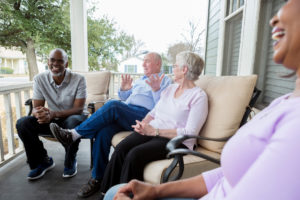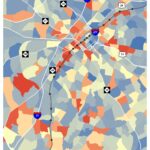Older adults often express a desire to remain living independently in their homes as long as possible. In order to meet this collective preference, especially in the coming decades, communities will not only need to offer more senior housing, but also housing that is more accessible and affordable.
The Joint Center for Housing Studies of Harvard University explains that housing supply in our nation is currently inadequate to meet the needs of an aging population for various reasons. For one, the expected growth in the older population will increase the number of renter households from six to more than 11 million over the next two decades. And renters, who typically have lower incomes, will be especially vulnerable. In fact, nearly 6.4 million renters will live in housing they cannot afford by 2035.
Keep reading to learn more about:
- Older Adult Housing Trends
- How Communities Can Help
- Housing Grants and Programs
- Community Planning Policies
Older Adult Housing Trends
In a December 2020 article from the Joint Center for Housing Studies of Harvard University, author Jennifer Molinsky summarizes older adult housing trends from the 2020 State of the Nation’s Housing Report. The following is a brief outline of those trends.
- Households age 65 and over are increasing faster than any other age group. The Joint Center projects that this population growth will increase from 29.9 million in 2015 to 49.6 million by 2035. Households aged 80 and over will increase at an even higher rate, more than doubling from 7.8 to 16.2 million by 2035.
- Older households are shaping both ownership and rental markets. With growth in the older population, the number of older homeowners increased by more than 2.5 million from 2016 to 2019. Simultaneously, adults age 55 and over contributed about two-thirds of rental housing growth from 2004-2019. This age group now constitutes 30 percent of all renter households.
- By 2035, the number of older households with a disability will increase by 76 percent. Homes will need more age-friendly elements such as zero-step entrances, single-floor living and wide halls and doorways that can accommodate walkers and wheelchairs.
 Households are shifting to include more combined generations. Rising costs in housing and healthcare, combined with growth among foreign-born households, which are more likely to include multiple generations, are contributing to an increase in multigenerational living.
Households are shifting to include more combined generations. Rising costs in housing and healthcare, combined with growth among foreign-born households, which are more likely to include multiple generations, are contributing to an increase in multigenerational living.
- Older owners are carrying more mortgage debt. Among owners age 80 and over, 27 percent were carrying mortgage debt in 2019, compared with three percent in 1989.
- The chance of facing a housing cost burden, defined as paying more than 30 percent of income on housing costs, rises with age, primarily because incomes decline in retirement. The incidence of households paying more than half their income in housing costs is particularly alarming, projected to reach 8.6 million by 2035. For both owners and renters, the numbers of severely cost-burdened households 80 and over will more than double.
- Funding for rental assistance and development of new affordable housing falls far below need even as the number of eligible older adults increases. HUD reports that in 2017, 39 percent of the nation’s nearly five million very low-income older renters faced worst case housing needs, meaning they were paying more than half their income on housing, living in severely inadequate homes, or both.
How Communities Can Help
The Joint Center of Housing Studies at Harvard University also offers the following steps that states and localities can take now to ease the projected housing strain among our elders:
- Increase accessible housing. The growth in the number of older households with mobility disabilities offers significant opportunities for the private market to provide new and modified accessible housing, as well as technologies that can enhance safety in the home.
- Providing tax credits and other financial incentives to help homeowners and landlords pay for modifications.
- Assist older owners with housing costs. Utility costs might be lessened through the installation of higher efficiency heating and cooling systems, solar panels, and weatherization programs, with tax incentives and grants helping owners to make the initial investment when costs are otherwise prohibitive. For those with mortgages they cannot afford but who still have substantial home equity, reverse mortgages may make it more financially feasible to age in place.
- Implement educational programs aimed at teaching adults in pre-retirement years how to avoid cost burdens in retirement, either by prioritizing the reduction of mortgage debt or by moving to more affordable housing at an earlier age.
- Increase subsidies to older renters. With the number of older low-income renters who qualify for federal rental assistance set to soar, increased funding will be needed to sustain even the one-third share of those eligible who currently receive assistance, still leaving almost five million unserved by 2035.
- Strengthen ties between health care and housing. Given the high cost of paid daily care in the home, continuing innovation in its funding and delivery is needed.
Housing Grants and Programs
Our Centralina Community Economic Development department assists communities with the preparation and administration of Community Development Block Grants (CDBG) Neighborhood Revitalization (NR) housing repair grants. The grants are offered through the Rural Economic Development Division of the North Carolina Department of Commerce. This program has an annual competitive application cycle. Our staff also help counties with the administration of Essential Single Family Repair Loan Pool (ESFRLP) programs offered through the North Carolina Housing Finance Agency. Each county is eligible to receive ESFRLP funds every three years.
ESFRLP funds and CDBG-NR grants focus on providing housing repair assistance to address health, safety and building code issues. Applicants are typically age 62 years or older and have owner-occupied, low to moderate income households (less than 80 percent of the county median family income).
Community Policy Guide
The American Planning Association (APA) recognizes that urban and regional planners have a responsibility to help implement policies that serve the needs and abilities of older adults. Due to this recognition, the APA adopted an Aging in Community Policy Guide in 2014. Topics included in this policy guide are:
- Engaging older adults in the planning process
- Policies that promote affordable housing
- Transportation and land use planning
- Economic wellbeing of older adults and caregivers
- Community assets and supports
Centralina Regional Council has used this policy guide as a reference, particularly the transportation and land use sections, throughout the development process for CONNECT Our Future and the CONNECT Beyond regional mobility plan.
For more information on this subject or how Centralina can help, contact info@centralina.org.




